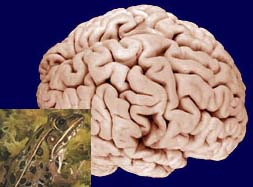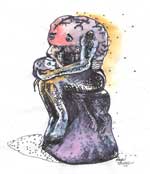Serendip is an independent site partnering with faculty at multiple colleges and universities around the world. Happy exploring!
Bio 202, spring 2010 - Notes, con.

|
How to tell less wrong stories (guess well): using multiple perspectives ... to add location and depth
| Binocular stereopsis resolving conflict |
But ... creating ambiguity |
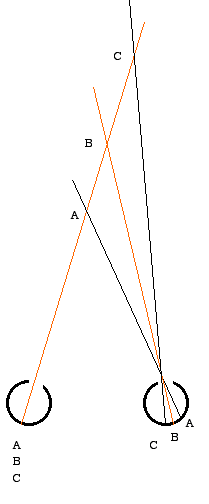 |
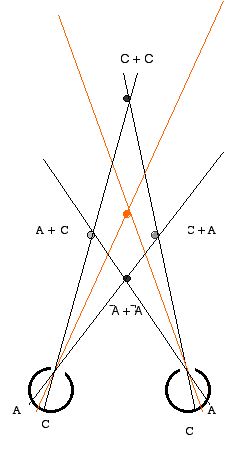 |
From the forum
We talked in class about how we only see color if our cone system is activated. I remember doing an experiment in high school biology in which an object was put in an observer's periphery vision, and the observer stated whether he saw the color first or the shape of the object first ... Lauren McD
I also found the point that colors are fully dissociable from wavelengths to be very interesting because I was always taught that a specific wavelength needed to be prevalent to see a particular color such as red ... Saba Ashraf
I always thought the way I perceived the color was correct and didn't understand why we all saw colors differently .... mcchen
how is it that, despite our inability to see every color in the exact same way as another person, we as a whole have come to recognize “blue” as blue and “red” as red, etc.? ... cschoonover
Jonathan I. (a 65-year-old artist), was in a car accident. Afterwards, Jonathan had transient amnesia, transient alexia (inability to read), and the inability to see color. This was devastating to the artist who had been known for his vibrant paintings. What was going on in his brain to cause this inability to perceive color? The phenomena occurred too quickly for it to be due to damage in the eyes, and in fact the patient reported that his “vision had become much sharper, that of an eagle.” Jonathan I. was also unable to construct color in his mind, his memories, and his dreams. He was unable to remember what color ever looked like. The patient was tested and it became clear that he could discriminate wavelengths! ... natmackow
Now I think about it, I always knew that what we perceive is a construction of the brain and there is no absolute truth in the things we see (or there is, but we wouldn’t know) ... I think I expect something more than “informed guess based on presumptions” for our brains ...yml
Maybe we’re not actually “seeing” anything but rather out brains are just filling in everything according to expectations ... Andy Mittleman
We don’t see the same thing, and to be honest, I like that. If there weren’t differences like these, life would get boring pretty fast ... Jeannette Bates
This question "if the brain imposes its own construction on perception, how much of what we actually see is real (versus "fake" or an "illusion")?" seems to be popular in this forum. However, I'm beginning to develop a distaste for the label "illusion" or "fake." I don't think any part of life, generally, is an illusion. People do have different perspectives and backgrounds that help create a range of lenses with which they can experience life. Maybe in a vacuum, we would and could see the world as it truly is (color as a physical entity). But in this world - our world - where social interaction, social construction, cultural and societal bias is nearly unavoidable, we see color because our brain wills it or constructs it ... skim
it's nice to now know that if I do not quite correctly pronounce words in foreign languages, the judge’s brains will hopefully fill in what they think I was supposed to sing ... Colette
Is the fact that we don’t easily notice when someone changes something about their appearance, like their hair or glasses, related to our reliance on mental pictures and filling in the lines? ... araeber
I do graphic design with computer sometimes, and I know there is a big difference between the color spaces on computer and in print - and the range of colors we can see is much wider than both systems ... Congwen
by asking these questions of perception and doubting our own reality, are we reaching a truer understanding? I personally doubt we could ever 'see' reality ... It is however interesting that we seem to have come to somewhat of an enlightenment by realizing these limitations, and attempting understand why they exist. If we know our vision is limited by the capacity of our rods and cones, than we can begin to imagine or create a picture of the world that is not limited thus ... dvergara
I found this interesting article Color Plays Musical Chairs In The Brain .... What this study looks at is what happens when color loses the object to which it is linked .... instead of disappearing along with the lost object, the color latches onto a region of some other object ... molivares
why do I even need this I-function? It is kind of getting in my way ... Schmeltz
Nervous system always has five ways to do the same thing - multiple depth cues
Better "picture" by making use of multiple perspectives, accepting/making use of "conflicts", picture in head a story/informed guess
3-D space and time features of story teller, not "reality"? (more than 3 dimensions in the unconscious)
Ambiguity as fundamental in seeing (Hofstadter's Road Sign), sensory systems generally
Can be reduced by using multiple cues, not eliminated (a "useful" gap?)- Picture in head could be otherwise
Ambiguity makes possible the creation of things that haven't previously been seen/conceived (impossible figures)
Lessons from color and ...
- "color" is a function of brain, not of physical reality
- Add color contrast, like brightness contrast - Serendip
- Does a tree falling in the woods make a sound if no one is there?
- perception is different in different organisms (Goldsmith, Scientific American, July 2006)
- Most vertebrates have four cone pigments
- Most mammals have two
- perception different in different people
- Color "blindness" (alternate)
- Human tetrachromacy
- what is "real"? does it matter?
- what is "normal"?, the issue of "Culture as Disability"
- multiple perspectives advantageous? generative?
- sensory info, like motor output, coded across populations
- brain creates "platonic ideals" - "categories" which "work"
- a "gap" between the "physical" and the "mental"?
- allows creation of things which don't exist in physical reality - non-spectral colors
- is all done without the I-function
- there is a difference between knowing how to do something and EXPERIENCING doing something - a "crack"? another hint about the existence of and role of the I-function?
relates to The Content and Epistemology of Phenomenal Belief, by David Chalmers, and Vision in a Complete Achromat, written by a vision scientist.
The picture in the head always an hypothesis, checked and rechecked ... ? The sky ... and the self ... and reality always an hypothesis? Where is the picture in the head, and what does all this have to do with the I-function/story teller? Could that be the doubter, the entertainer of previously unconceived alternatives? "reality" created by the story teller as a stimulus for checking?
- Disconcerting ... but also liberating?
- individual creativity
- value of interpersonal sharing
The bipartite brain: where is the picture in the head? the I-function/story teller?
Multiple ganglion cell types - frog
- contrast and color opponency
- multiple samples
- motion
Retinal projections ... another ... another
- multiple targets
- midbrain
- thalamus -> striate cortex
- different, parallel functions
... beginning to bring images together, creating a new reference frame
Moving on to neocortex
Remembering some relevant comparative neuroanatomy - neocortex as parallel to rest of nervous system
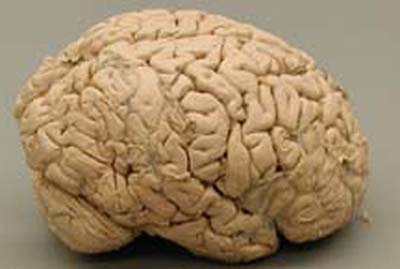 |
 |
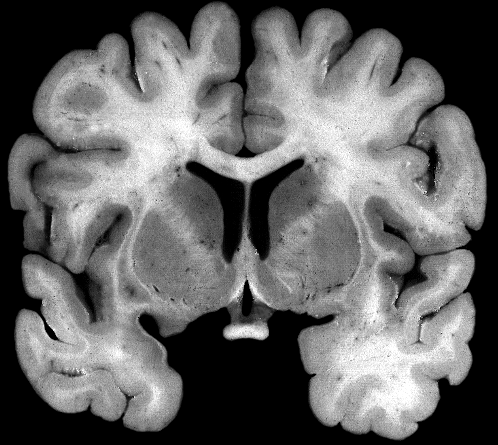 |
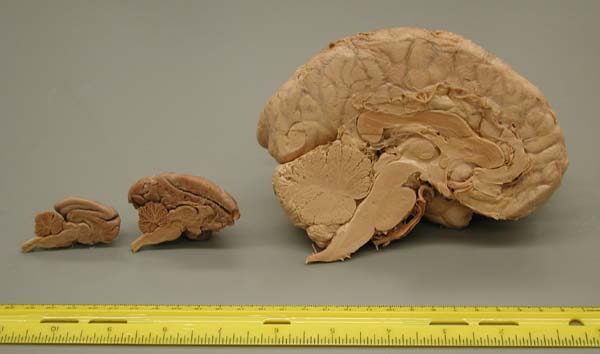 |
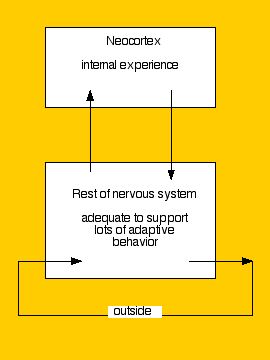 Visual Cortex - binocular convergence, altered "feature" detection, columnar organization, topographic organization
Visual Cortex - binocular convergence, altered "feature" detection, columnar organization, topographic organization
- Picture in head not in striate cortex
- parallels to topographic organization in motor cortex
- laterality re what looking at rather than re "self"
- unlike picture in head, representation in visual cortex moves when eyes move
Multiple cortical visual areas
- Color and motion dissociable
- Partial color deficits
- motion blindness
- face blindness
- Distributed "picture in head"
From the forum
When discussing the movie "Beautiful Mind" about the schizophrenic John Nash, it made me wonder--aren't we all a little schizophrenic? ... Colette
From they way we’ve been talking about vision, the I-function and stories in class, it would be easy to say “we’ll never truly know what ‘reality’ is because everything we perceive is only a story in our heads” and be done with it. I don’t think that is a useful thing to do ... We can make several different stories about what we see, but we can’t really make an infinite number of plausible stories. This leads me to believe that there is some degree of “truth” to the images, or at least we are all similarly limited in what we are able to perceive ... kdilliplan
how much of the commonality in human experience is based on learned terminology and cultural ideas and how much of it really is the same? ... araeber
I always think pointing the direction with our hands mainly involves our I-function, but now I'm not so sure. After all, how can those patients use their I-function to point out the light correctly, when their I-function is not even aware of the light? ... Congwen
Despite our “i-function” knowledge that our initial interpretation of these images cannot possibly be real, our NS still believes the story until given further input. This seems to suggest that the NS’s interpretation of visual, auditory, and other sensory inputs override any such knowledge the “i-function” has about what is being sensed. How involved is the “i-function” in seeing these images? ... natmackow
The more we learn about the I-function and its role in shaping our images and perceptions, the more confused I am about its purpose ... meroberts
some of the greatest technological advances have been the result of creating a picture or story in one’s head of something that has never been seen before ... cschoonover
I don't think I find it as unnerving as I should that our brains don't actually see reality precisely for the fact that because of this, it makes it possible to imagine things that could otherwise never exist ... lfrontino
I found it very interesting that in class, when looking at the optical illusions, it took me a long time to see the other possible construction. It seems that my brain constructed one image and held on to the belief that it was the actual and only possible image. In order to see the other possible construction, I either had to really concentrate on the image or I had look away from the image for a long time and suddenly look back ... MEL
while I was trying to see the optical illusion differently, I had to sort of erase what I already thought I saw and start again with a clean slate. I think the sense of "erasing" what I thought I perceived definitely had to involve the I-function in some way ... mcchen
we gain a more dynamic relationship with our sensory input. Perhaps we learn how to interpret these inputs in more complex ways. More importantly, we seem to realize that our senses should not be endowed with unquestioning faith ... AndyMittelman
Blindsight and its implications - Don't NEED "picture in head"
- What IS "picture in head" for?
- internal experience
- Self as object
- I-function ("story teller"?) in neocortex? constructed ("story"), testable, reconceivable, "imaginary" and hence re-imaginable
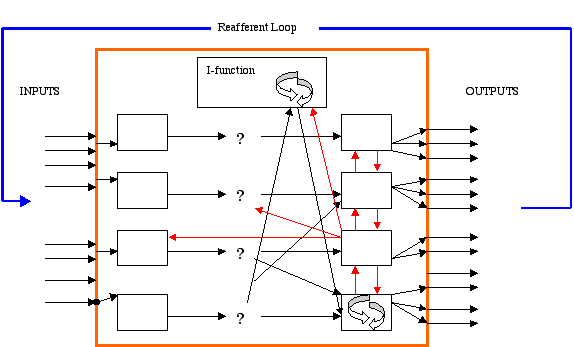 Lessons from sensory side ...
Lessons from sensory side ...
- distributed systems
- ns "creative", "reality" an hypothesis rather than a touchstone?
- distinction between responding and experiencing, I-function/story teller
- picture in head = pattern of activity in neocortex, thoughts/ideas?
- I-function/story teller relates to neocortex?
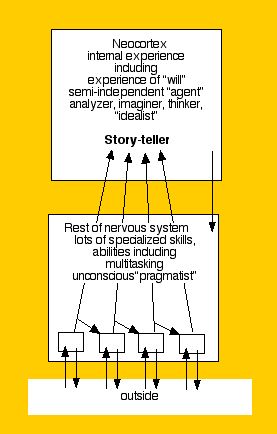
Picture in head a distributed construction, a story, not necessary but allows for conceiving things in new ways
I-function associated with neocortex, neocortex a story teller
I-function a part of story teller, that allows story to influence behavior, that allows one to entertain alternative stories?
What is self? emotion?
Look more at "bipartite brain"
Further evidence for a bipartite architecture in other realms - generalized control mechanisms
Personality, self?
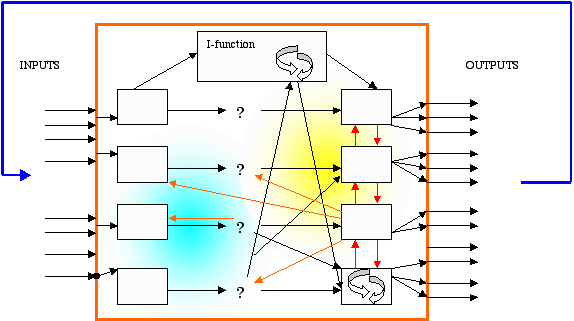 "generalized control mechanisms"
"generalized control mechanisms"
- wide spread changes of state
- pharmacological involvement
- degree of autonomy
as an instance
- more on independence from I-function, on expectation generation
- more on I-function ("story teller") localization/independence
- human behavior without an I-function (dissociative fugue)
- interplay of unconscious and I-function (story teller) to yield "self"
Schizophrenia
The Bipartite Brain: Further evidence and new directions
So far
 |
 |
- One can act without the experience of acting
- One can see without the experience of seeing
- One can be, distinctively, without the experience of being
- The experience of seeing is a construction, a story, an assembly built of many parts, somewhat arbitrarily and potentially different
- Also true of acting, being, and ... ?
One can have "emotions" without the experience of them ("feelings")
- Damasio
- psychopathology - thought without feelings
- Capgras syndrome (Ramchandran)
- feelings/intuitions a story, could be otherwise
- primary vs elaborated stories
 |
 |
One can be affected by experiences (learn) without the experience of having been affected by them (memory)
- dementia and the unconscious
- implicit vs explicit memory
- body language
- tacit knowledge
- memory a story, remade each time its experienced (Memento)
- Damasio: proto-self, core self, autobiographical self (cognitive unconscious, primary story, elaborated story)
The I-function as part of the story teller
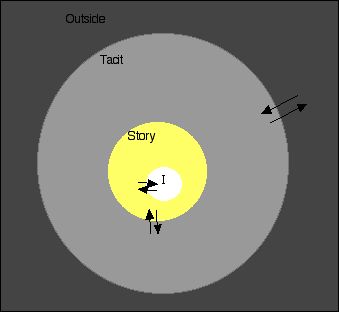
Two interacting systems
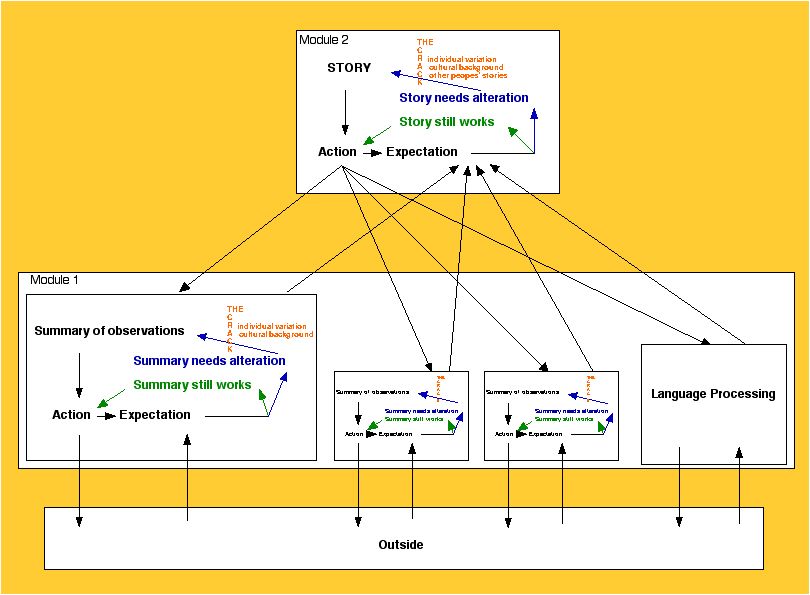
The bipartite brain and culture
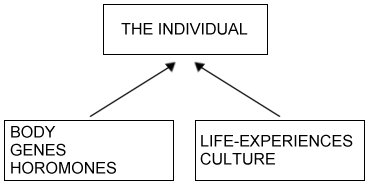
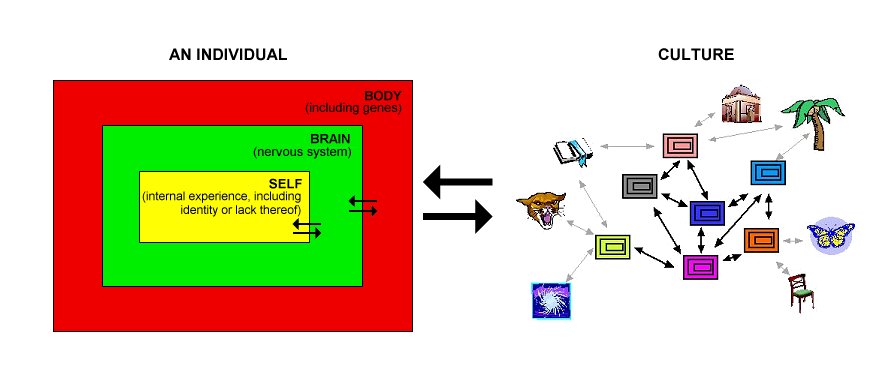
from The Brain and Social Organization
Interacting individual and cultural stories
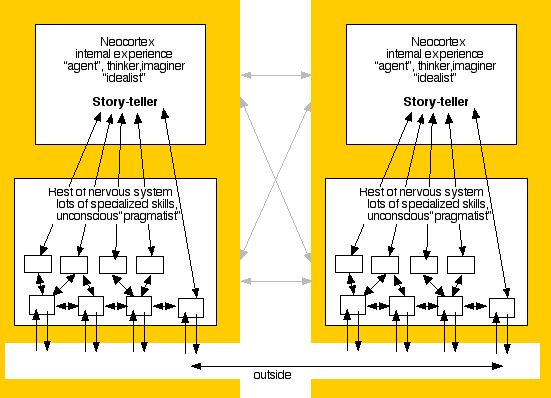 Advantages and challenges of the bipartite brain
Advantages and challenges of the bipartite brain
Learning to live with/enjoy the bipartite brain
Writing Descartes: I Am and I Can Think, Therefore ...Paths to Story Telling As Life
- Genes are valuable, but don't take them too seriously
- Experiences are valuable, but don't take them too seriously
- Feelings are valuable, but don't take them too seriously
- Cultural stories are valuable, but don't take them too seriously
- Personal stories are valuable, but don't take them too seriously
- Stop looking for the "answer" and look instead for what's "less wrong," for new directions to create
Bottom line of story of brain=behavior:
- Believe in where one is, has come from (including genes)
- Challenge self/others, dream/imagine/create
- Share stories
- Repeat over and over again
and what I find around me
Thanks all for contributions to the evolution of my story, and that of others. Keep enjoying the evolution of your own ...

